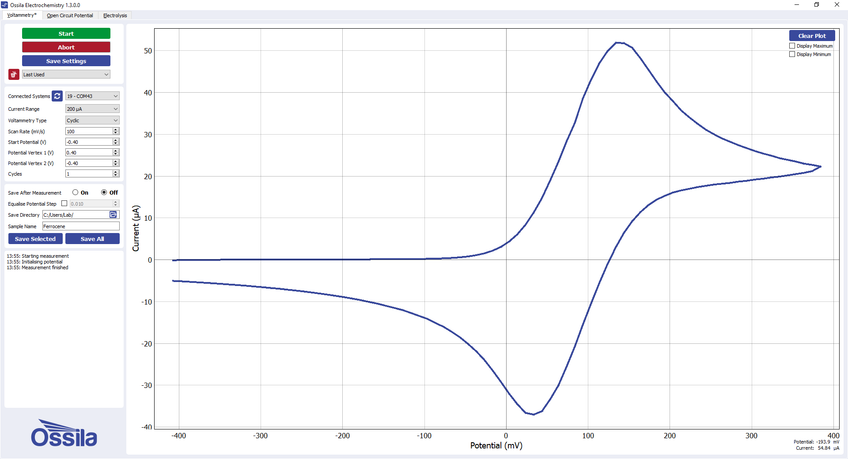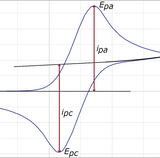Potentiostat
Electrochemistry Supplies, Lab Equipment,Low Price, Compact Potentiostat for Electrochemistry
Available with electrochemical cell and electrodes; everything you need to get started
Overview | Specifications | Features | Gallery | Software | In the Box | Accessories | Resources and Support
The Ossila Potentiostat is a powerful electrochemical measurement device for performing linear sweep voltammetry, cyclic voltammetry, open circuit potential, and controlled potential electrolysis. Designed for both experienced chemists and newcomers to the field, the easy-to-use PC software makes it straightforward for anyone to take accurate and precise measurements across a wide potential and current range.
Purchase with or without an electrochemical cell, non-aqueous Ag/Ag+ working electrode, platinum disc reference electrode, and platinum wire counter electrode. No research or teaching lab should be without an Ossila Potentiostat.
Two-Year Warranty
Buy with confidence
Versatile
Can be used in multiple experiments
Powerful Electronics
Capable of outputting potentials of up to 7.5 V
Free Software
Intuitive PC software included
Specifications
| Potential Range | ±7.5 V |
|---|---|
| Potential Compliance | ±10 V |
| Applied Potential Accuracy | ±10 mV offset |
| Applied Potential Resolution | 333 µV |
| Maximum Current | ±200 mA |
| Current Ranges | ±20 μA to ±200 mA (5 ranges) |
| Current Measurement Accuracy | ±20 nA offset (at 20 μA range) |
| Current Measurement Resolution | 5 nA (at 20 μA range) |
| Communication | USB-B |
| Overall Dimensions (W x H x D) | 125 mm x 55 mm x 175 mm (4.91" x 2.17" x 6.89") |
| Weight | 600 g (1.32 lb) |
Standard Electrochemical Cell Glassware (Optional)
Screw-fit PTFE lid with three electrode holes and two gas holes.
Platinum Disk Working Electrode (Optional)
Highly polished platinum embedded in polytetrafluoroethylene (PTFE) plastic bodies.
| Purity | 99.99% |
|---|---|
| Diameter | 2 mm |
Platinum Wire Counter Electrode (Optional)
| Purity | 99.99% |
|---|---|
| Diameter | 0.5 mm |
Non-aqueous Ag/Ag+ Reference Electrode (Optional)
Aqueous Ag/AgCl Reference Electrode (Optional)
User Manual
Potentiostat Features
Wide Potential and Current Range
To allow for a wide range of material characterization, the Ossila Potentiostat is capable of outputting potentials of up to 7.5 V and can measure currents over five ranges from ±20 μA to ±200 mA.
Accurate and Precise
With an applied potential accuracy and resolution of ±10 mV and 333 µV respectively, and a current measurement accuracy and resolution at the 20 μA range of ±20 nA and 5 nA, the Ossila Potentiostat is both accurate and precise.
Range of Electrochemical Measurements
The Ossila Potentiostat is a powerful, low price potentiostat for cyclic voltammetry, linear sweep voltammetry, open circuit potential, and controlled potential electrolysis.
Proven Quality
Our experience building measurement devices paired with free Ossila Electrochemistry software, provides an easy-to-use platform for testing and characterizing materials. With internal circuitry based on our highly popular source meter and an aluminium outer case, the potentiostat is both reliable and durable.
Compact and Light
At only 12.5 x 18.5 cm, the small footprint makes it completely lab-proof and glove box friendly (we use it extensively in our own lab to electrochemically characterize our range of materials). Our potentiostat fits easily inside the main chamber of a lab glove box for measuring air or moisture sensitive materials.
Potentiostat Gallery

Testimonials
We're happy with the Ossila Potentiostat. We're currently using it in teaching labs to demonstrate basics of corrosion measurements. It is compact, easy to use, and affordable.
Branislav Dzurnak, Czech Technical University in Prague
The Ossila Potentiostat is small, portable and easy to use. We also bought the three electrode cell and this provides a stable set-up to hold the electrodes in convenient positions.
Top automotive manufacturer
Software
The Ossila Potentiostat comes with control and measurement software for performing linear sweep and cyclic voltammetry, open circuit potential, and constant potential electrolysis. Software updates are also provided at no extra charge and are available to download from our website.

The Ossila Electrochemistry Software
Our intuitive potentiostat software enables you to easily perform linear sweep and cyclic voltammetry, open circuit potential, and controlled potential electrolysis. Simply set the relevant settings and click 'Start'. Watch the measurement as it happens with live plotting of data.
As with all of our software, data is saved to comma-separated value (.csv) files so that you can analyse it with your favourite tool. The settings you define are saved alongside your measurement data so that you always have a record of your experimental parameters. Profiles allow you to save commonly used settings configurations so that you can quickly repeat measurements without re-configuring the potentiostat, further speeding up your research.
Software Requirements
| Operating System | Windows 10 (32-bit or 64-bit) |
|---|---|
| CPU | Dual Core 2.5 GHz |
| RAM | 2 GB |
| Available Hard Drive Space | 120 MB |
| Monitor Resolution | 1280 x 960 |
| Communication | USB 2.0 |
Software Installation
To install the Electrochemistry PC software, download the latest version from our website or insert the supplied USB memory stick into your computer and run the "Ossila-Electrochemistry-Installer-vX-X-X-X" file.
On Windows 10, the necessary drivers are installed automatically when you first connect the Potentiostat to your computer. If you are using an older version of Windows you can find both 32-bit and 64-bit drivers either on the software download page or in the "SMU-Driver" folder on the memory stick.
Please refer to the Potentiostat product manual for more information.
In the Box
- Potentiostat
- Shielded cable and crocodile clips
- Test cell chip
- USB-B cable
- 24 VDC power adaptor
- USB Driver with QC test data
Included if purchased with a cell:
- Standard electrochemical cell*
- Platinum disc working electrode*
- Platinum wire counter electrode*
- Non-aqueous Ag/Ag+ or aqueous Ag/AgCl reference electrode*
* Available to be purchased separately
Accessories and Related Products
Resources and Support
 Potentiostat Working Principles and Fundamentals
Potentiostat Working Principles and Fundamentals
Potentiostats are voltage sources that vary their output potential in response to changes in the resistance across the circuit.
Read more... Cyclic Voltammetry Applications and Uses
Cyclic Voltammetry Applications and Uses
Cyclic voltammetry is a versatile electrochemical method with a range of different applications. In cyclic voltammetry, each successful forwards and backwards potential sweep produces a 'duck-shaped' plot known as a cyclic voltammogram.
Read more...



